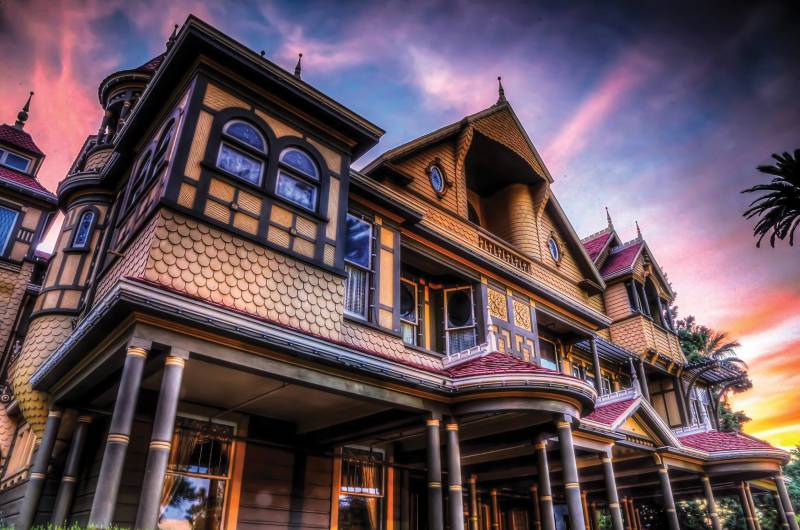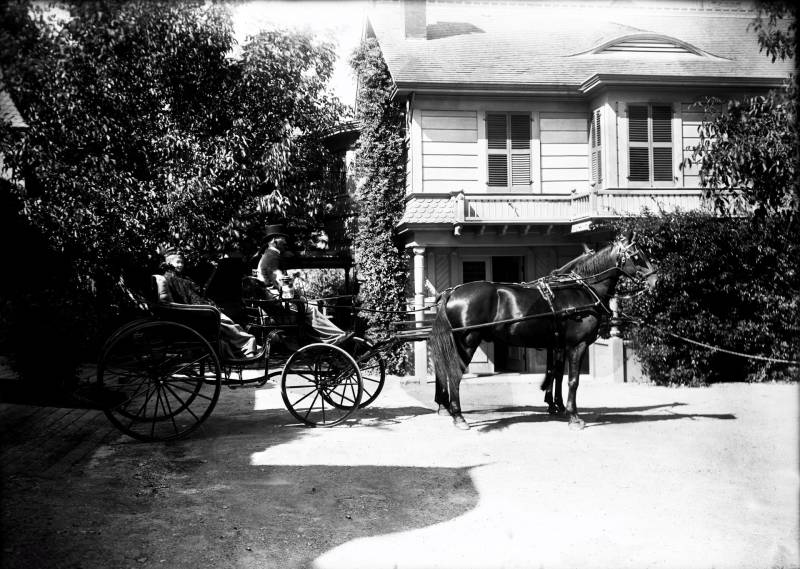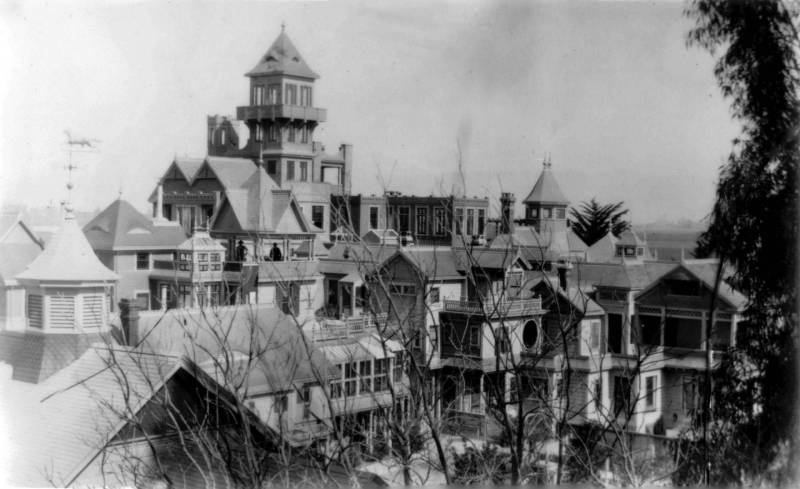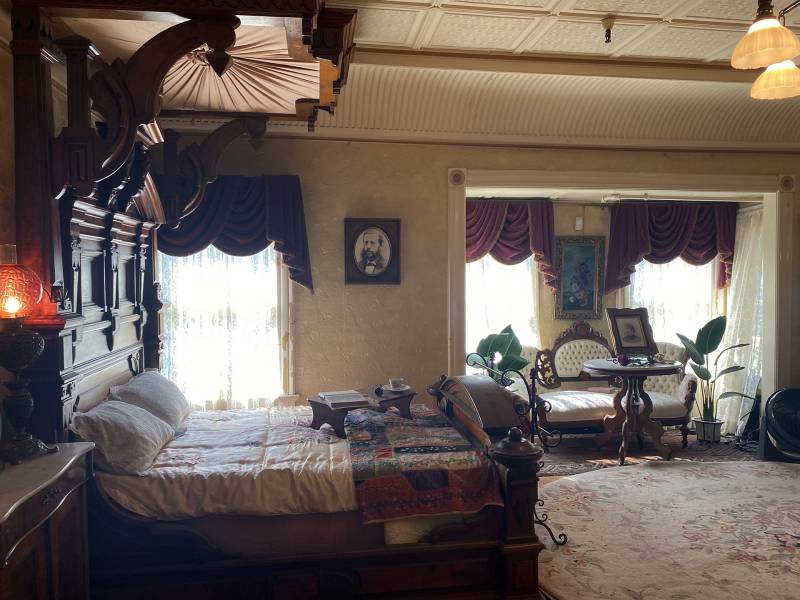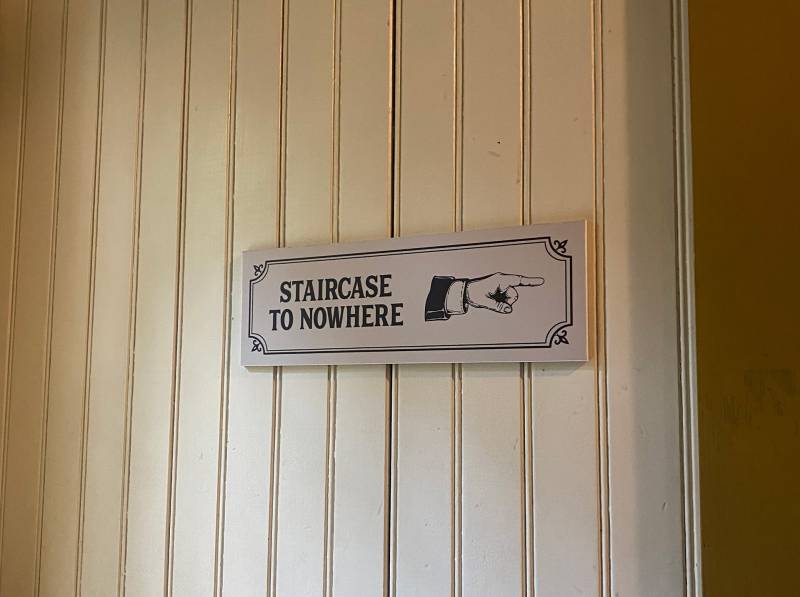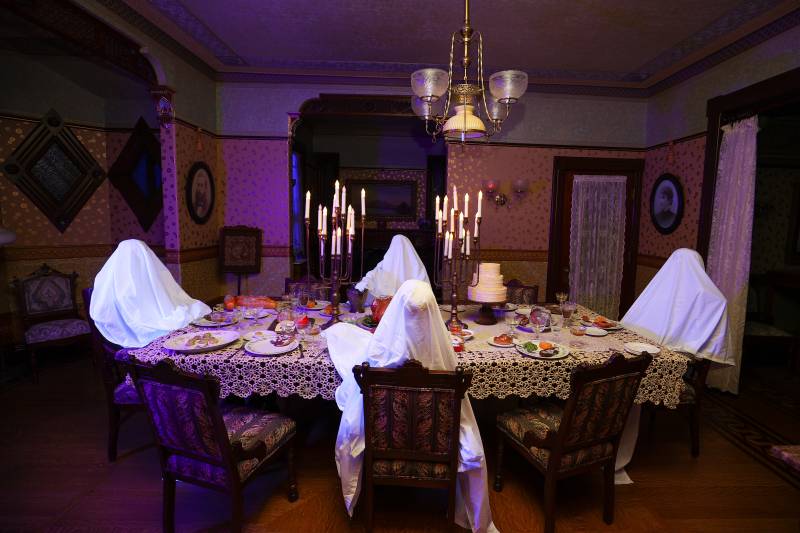Episode Transcript
This is a computer-generated transcript. While our team has reviewed it, there may be errors.
Carly Severn (in scene): Where are we, Olivia?
Olivia Allen-Price (in scene): We are just outside the entrance to the mansion tour at the Winchester Mystery House in San Jose. And I’m so excited to be here. I have been here before, but it’s been a really long time.
Olivia Allen-Price: The Winchester Mystery House is one of those places that’s in all the tourist guidebooks. A spooky historic attraction that’s kinda like Alcatraz, or riding a cable car, in that many people who grew up here know about it — but have never visited.
Announcement (in scene): The Walk of the Spirits tour at 12:10 is departing at the front of the house on the front porch.
Olivia: One crisp fall day in the South Bay, with Halloween just around the corner, reporter Carly Severn and I braved a tour of the sprawling house.
Music begins
Olivia: It’s a disorienting maze of rooms. Staircases leading to nowhere. And then, there are the ghosts … This is Boo Curious. Your tour of the Bay Area’s creepiest places. Today on the show, to kick off our month-long series, we’re taking you inside the eerie Winchester Mystery House … and unpacking the ghostly legend that’s apparently behind it all. I’m Olivia Allen-Price. Now stay close. You don’t want to get lost..
Sponsor message
Olivia: The Winchester Mystery House may be internationally famous for its bizarre, otherworldly architecture — and stories about the ghosts who still stalk its corridors. But almost 140 years after its construction, the real mystery of this place is actually about the woman who lived … and died … within these walls: Sarah Winchester. Let’s go over the threshold with reporter Carly Severn.
Alexis, our tour guide: Welcome to the Winchester Mystery House. My name is Alexis. I’ll be your guide today for your hour-long tour of Mrs. Winchester’s beautiful yet slightly unusual mansion.
Carly Severn: The Mystery House is so confusing, so labyrinthine, that one of the first things our tour guide tells us is: don’t go wandering off alone.
Alexis: Just stick with me at all times. It’s really easy to get lost inside this home. So I’m your only way out of here alive.
Carly: And if the name of this place sounds familiar to you, that’s because it’s “Winchester” as in “Winchester Rifle” — one of the most notorious guns in history. Death was right there in Sarah Winchester’s name.
Start slow but propulsive by lonesome piano music
Carly: The Winchester Repeating Arms Company was one of the biggest, most profitable weapons manufacturers of the 19th century. And by marrying into the family that owned it, Sarah Winchester was the heiress to that fortune.
Carly: The legend goes that Sarah moved from the East Coast to California after a psychic told her that building this bizarre place would appease the angry ghosts of all those people killed by Winchester rifles.
Sound Effect: Ghost moan
Carly: Ghosts she spoke to in seances, sequestered inside her house of mystery.
Music out
Carly: This is also the version of this story that’s repeated in the 2018 horror movie “Winchester,” which stars Helen Mirren as Sarah.
Helen Mirren Clip from Film: The spirits… killed by the rifle…. They guide me. The bells summon them… They communicate through plans, drawings … they want me to reconstruct the rooms they died in … then they can enter our world.
Carly: And when you’re inside it, on one of their public tours, it’s kinda plausible that this mansion was designed by someone who wasn’t, shall we say … fully operating on this astral plane?
Olivia (in scene): I don’t know what floor we’re on. Like, we could be on the seventh floor. We could be on the third floor, like with the staircases being strangely sized and shaped. It’s very disorienting. Yeah.
Carly (in scene): This place, you kind of get lost the minute you step through the door.
Start weird, slightly campy, mysterious music
Carly: The Winchester Mystery House sprawls across 24,000 square feet. It has 160 rooms, including 13 bathrooms. There are 17 chimneys, 47 stairways – many of which lead nowhere — 2,000 doors and 10,000 windows. If you built the Mystery House today, construction costs would come to $71 million.
End music
Carly: The house itself is fascinating. Yet as the tour makes clear, the woman behind it — the one who locked herself away in this dark, doom-laded place — is even more so.
Alexis: I really love this house and the history behind it, but mainly I love Sarah more than anything.
Carly: But with so much rumor and legend, what do we really know about Sarah Winchester?
Start lonesome percussive string music with swells and quiet
Alexis: Now, everyone knows Sarah as Sarah Winchester, but she was originally born as Sarah Lockwood Pardee. She was born in 1839, New Haven, Connecticut. And she grew up very well-educated in life.
Carly: Sarah married the Winchester heir, William, in 1862. But she was then fated to suffer multiple waves of devastating loss in her life.
Carly: In her twenties, she lost her only child when they were just 5 weeks old. Fourteen years later, in 1880, her father-in-law died. Followed closely by her own husband, and then, her sister. And the legend goes, it was at that point that Sarah decided to move out to California — on a desperate quest at the behest of a psychic. Right?
Music end
Mary Jo Ignoffo: I don’t hold the general public responsible for misperceptions. It’s really a 100-year-old marketing campaign.
Carly: This is Sarah Winchester’s biographer, Bay Area writer Mary Jo Ignoffo. And she says that first off, this spooky relocation theory just doesn’t check out.
Carly: Mary Jo says Sarah’s own doctor was urging her to seek out warmer climes that would be better for her health, and grief. What’s more, Sarah didn’t move out here alone. One of her surviving sisters was already planning to leave the East Coast for Oakland.
Mary Jo Ignoffo: It’s not so much that a psychic told her to go as family circumstances and life led her to California.
Carly: But could Sarah have felt that creeping worry that the victims of Winchester guns might come back to haunt her? For Mary Jo, the big problem with this theory is how much Sarah chose to remain involved with the Winchester Repeating Arms company even after her husband’s death. Sarah stayed on as an active, highly engaged member on the company’s board for years — when she could have just … cut loose with her money.
Music beings: piano, inspired, forward moving, but still lonely
Carly: Sarah landed in the Bay Area already a keen amateur architect. And in 1886, she purchased a modest two-story farmhouse in the San José area — and converted it into her giant mansion.
Mary Jo: It was her canvas. She would say, oh, try it this way. No, I don’t like that. Rip it down. Let’s try it again. Oh, I like this wood better.
Carly: The construction consumed her for over three decades.
Mary Jo: She kind of unleashed her interior design, artistic talents, her desire to be an architect on that house.
Music end
Carly: Sarah’s new San Jose neighbors were baffled, and the local press became fascinated. And they weren’t just intrigued by the scale of her ever-expanding compound. They were also mystified by the Winchester widow herself.
Carly: She was a hyper-private outsider, who shunned the aristocrats of the South Bay social scene. And despite all that interest, Sarah stayed silent as the grave about what on earth — or maybe elsewhere — was driving her to keep expanding and transforming her strange, sprawling home.
Carly: She was also one of those most unfathomable creatures: a single woman, who had no interest in making other people comfortable with explanations.
Mary Jo: She would not talk to the press. And so they started creating stories.
Carly: One rumor at the time claimed that Sarah believed eternally re-modelling the house would keep her alive. Others said that Sarah was obsessively trying to contact the spirit world through those seances of hers.
Mary Jo: And then finally, the last iteration is: she’s crazy.
Music enter: cinematic, ambient, matter of fact not too sad
Carly: The new century arrived. Sarah grew older, and older still. By the last decade of her life, she owned many homes around the South Bay — not just the Winchester Mystery House. It was in one of these other houses that she actually chose to spend most of her final years.
Carly: But in the very end, something drew her back – and it was to the Winchester Mystery House that Sarah returned to see out her last days on earth, alone. She died inside the house of heart failure in 1922: A Victorian from another era in the Roaring Twenties, who lived long enough to see the first airplane fly … and the Titanic sink. After all those years of construction, Sarah’s house finally fell silent…
A few seconds of silence…
Carly: But … it did not stay silent for long.
Music begins: Busy, opening, ’50s-era sounding, faster paced
Carly: Just months after Sarah died, in the spring of 1923, the mansion was leased by a couple who apparently planned to build an amusement park on the site, complete with a rollercoaster, but they pivoted to offering public tours of the place.
Mary Jo: Her house was turned into a haunted house to attract tourists within months of her death.
Carly: The public thrilled to finally see inside Mrs Winchester’s house of intrigue, egged on by breathless promotion … like this 1929 advert from the Oakland Tribune:
Booming male voice reading newspaper clip: World’s most marvelous and oddest house. Under construction 36 years. Cost: millions. Builder guided by the spirits … Open every day 9 a.m. to 6 p.m.
Music out
Carly: But still, the question remains: Why does this place look so odd? According to the legend, Sarah intended these strange features by design to either confuse the spirits in her house — or as a way to pay homage to them, like decorating your home for Halloween.
Carly: But remember that when it came to architectural design, Sarah was an enthusiastic amateur learning as she went — and a lot of the apparent “mysteries” might simply betray those false starts. And then … there’s what happened in 1906.
Mary Jo: The house at its peak literally was seven stories. And in the earthquake of 1096, the top floors collapsed in on themselves.
Carly: This means all those weird doors, all those “stairs to nowhere” … might have led somewhere very real when they were first built.
Music begins: ghostly whaling
Carly: So now, we come to it. What about the ghosts? So much of this place’s appeal has been fueled by this legend of Sarah as a devoted Spiritualist. A lonely widow obsessed with inviting in the netherworld through her seances.
Carly: On the Mystery House tour, you can even place your hands on the table and hear the sounds of a seance echo around you:
Clip from seance demonstration in house: Sing all spirits hearken all souls. We gather to offer a clarion call to the spirit world as we seek to open a window for those who still reside here in the Winchester mansion.
Carly: Spiritualism was technically a belief system that hinged on attempting contact with the dead. And it was popular among upper-crust women like Sarah at this time. But Mary Jo says there’s no record that Sarah ever attended the local Spiritualist gatherings.
Carly: And this image of Sarah the recluse, shut away in her scary house communing solo with the dead, runs contrary to the whole point of Spiritualism:
Mary Jo: If you were to have a seance, you would not do it in a closet in the middle of your house. You would invite other like minded people. At its very most basic level, Spiritualism is a social enterprise.
Carly: … and Sarah had a well documented aversion to visitors in her house.
Music begin: playful, harpsichord, percussive
Carly: Of course, this hasn’t stopped over a century of rumors about an “otherworldly connection” making the Winchester Mystery House famous worldwide. Ghost hunters and supernatural enthusiasts report unearthly sightings and unexplained presences sensed in its winding corridors and infinite rooms.
Carly: And let’s face it, visitors who arrive at the Mystery House for its public tours today are coming in the hope of experiencing just that — as our tour guide Alexis can attest to.
Alexis: We sit down in certain areas on the Spirit tour, and I have had people ask me, what’s the most possessed seat? And I never know what to say to them. And I say, You know what? That one.
Carly: Even a total skeptic has to admit it, in that bright San José sunshine, this place is disorienting and claustrophobic enough to really give you the creeps.
Music end
Carly: In many ways, the Mystery House legends represent all the things that feel like they should be true — especially when you think of how you’d feel in Sarah Winchester’s shoes. How could a person get rich from making new instruments of death and not feel guilty? How could a lonely woman suffer such tragedy and never once feel the impulse to see if her lost loved ones could … talk back?
Carly: But what if the hard facts of Sarah’s life actually leave us with a far more recognizable story about how people react to overwhelming change and loss? How they can alienate themselves from the world in the process?
Carly: And let’s face it: When we talk about death through ghosts and ghouls, we’re offered straightforward, even pleasurable scares. It’s death in the real world, and what it does to the humans left living, that’s truly unsettling to dwell on.
Carly: So faced with that choice? Listen, if you go to the Mystery House and feel a sudden chill down your spine … well, maybe it’s hard not to feel your thoughts drawn to the supernatural in the right settings. Especially at this time of year.
Carly: On our tour, being led into the Mystery House’s dark, cold basement, we certainly weren’t immune from just that:
Carly (in scene): Okay … Descending stairs into the darkness. Okay. [Olivia heard muffled in background: “This is very dark!”] This is the thing; you can come in with all this, you know, “I’ve got my factual hat on”, and then you come into a dark room that’s cold, and you’re like, “Well .. Who’s to say? Who’s to say?!”
Carly: Because sometimes … even when we know the facts, it’s just far more appealing to indulge … in a little mystery.
Boo Curious theme music begins
OLIVIA: That was KQED’s Carly Severn.
OLIVIA: This is the first in our four part Boo Curious series this year. That’s right, the whole month of October we’ll be bringing out eerie stories, with a Bay Curious twist. Be sure you’re subscribed so you don’t miss the fun.
OLIVIA: This just in: Bay Curious is up for a Signal Award. That’s a listeners choice award for podcasts. We’d love if you could give us a vote. Find a link in our show notes or at BayCurious.org.
OLIVIA: Tickets are now available for our upcoming theatrical walking tour of the AIDS Memorial Grove in Golden Gate Park. Come Learn about the history of this amazing space from the people who helped create it. Plus live music, dance and The Sisters of Perpetual Indulgence. Space is limited. Learn more at KQED.org/live.
OLIVIA: This episode was produced by Amanda Font, Christopher Beale and me, Olivia Allen-Price. Shout out to Dan Brekke, for his voice work. Additional support from Jen Chien, Katie Sprenger, Cesar Saldana, Maha Sanad, Holly Kernan and the whole KQED family. Have a good one, everybody!
